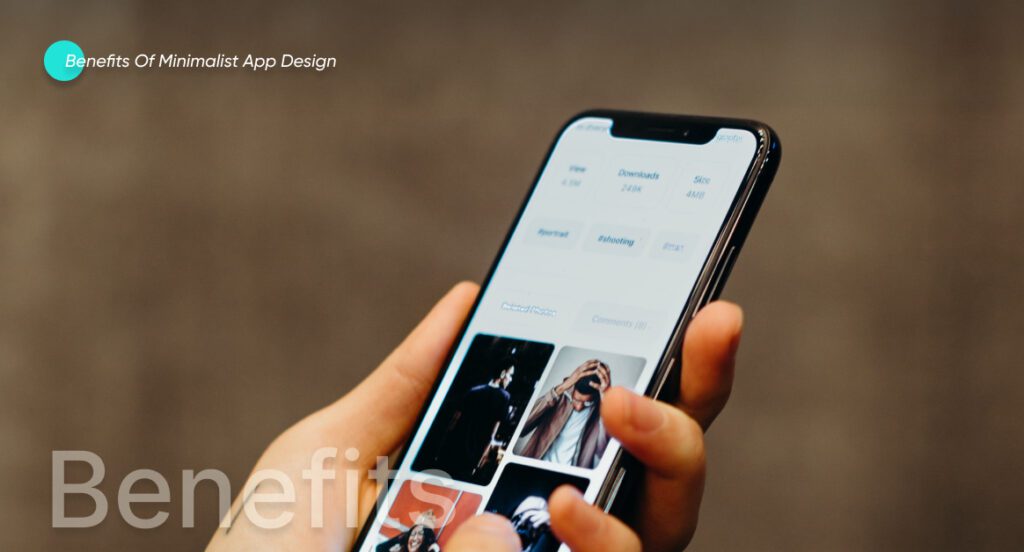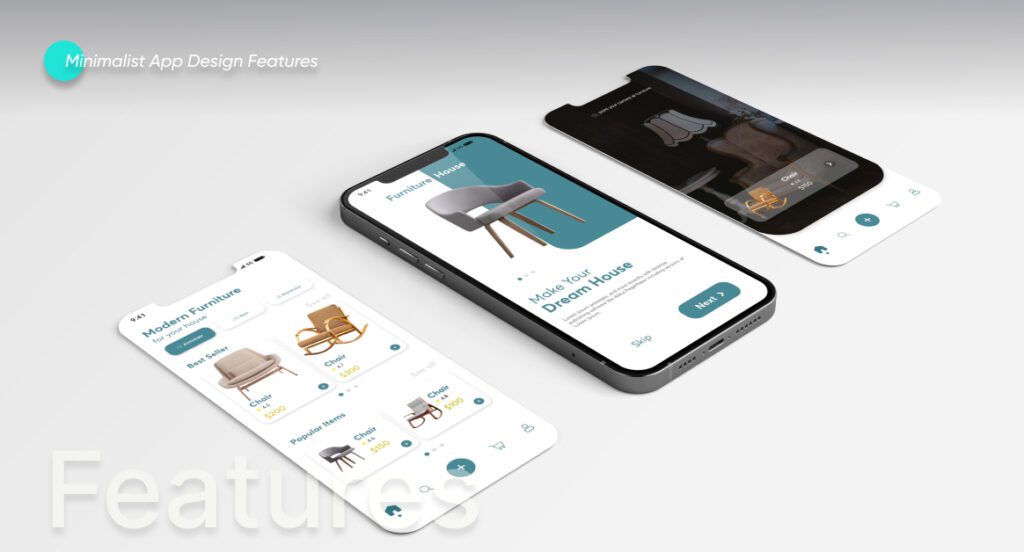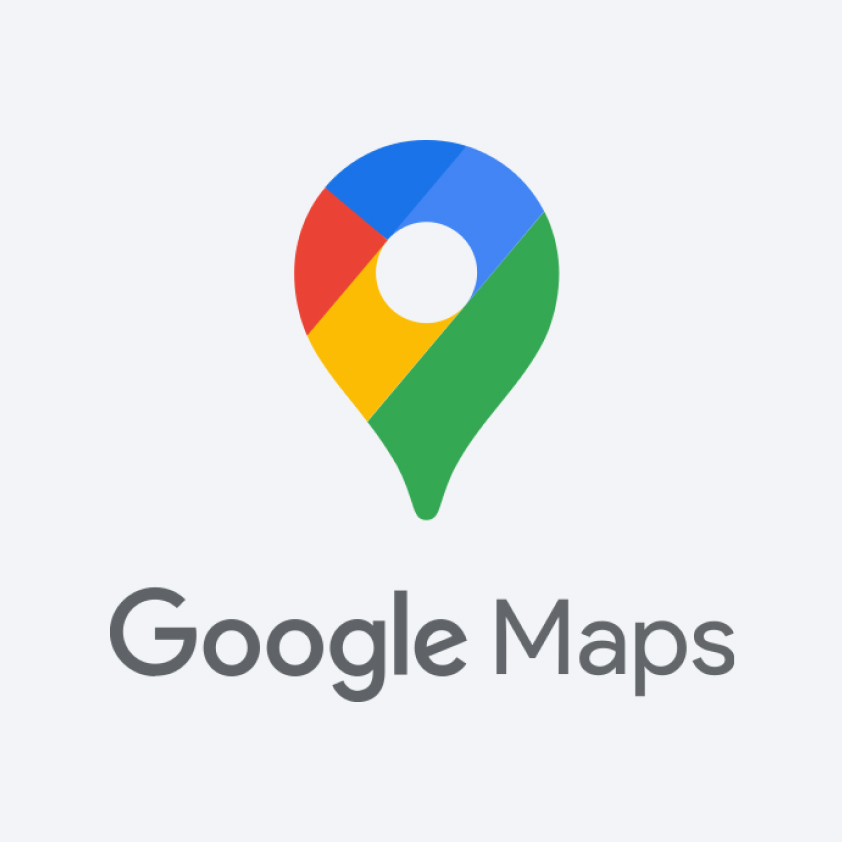What is Minimalist App Design?
Minimalism as an art movement began in the Post-World War II period and achieved incredible popularity during the 1960s and 1970s. Apart from leaving an indelible mark on visual arts, architecture, fashion, and literature, the minimalism movement also made inroads in the field of science and technology. Significantly, the minimalist app design was adopted by designers and developers, leading to a true fusion of elegance, simplicity, and user-friendliness.
Minimalist design in an app denotes a design style that embeds simplicity, clarity, and functionality in an app’s user interface (UI) and user experience (UX). The goal is to craft an organized and intuitive design that ensures easy navigability, excellent usability, and stunning aesthetics. Minimalist design in an app is an effective way to create a user-friendly and visually appealing app that prioritizes function and usability over unnecessary visual embellishments. In a nutshell, minimalist design is a combination of form and functionality.
An app’s minimalist design typically involves using a simple color palette, clean typography, a few graphical elements, and much white space. It also often deploys a flat design, meaning the app’s features are designed without depth, shadows, or gradients. In minimal app design, every element has a clear purpose and specific function. Unnecessary details are removed, and the design is focused on the essentials. It creates a clean, modern design, easy to use and understand.
This article aims to assess minimalist app design and its significance. Read the article to learn more.
Benefits of minimalist app design

Clarity
Minimalist app design can offer several benefits, and delivering a clear message is one. A minimalist design typically simplifies the visual elements and reduces clutter, allowing the most critical information or message to stand out. It helps avoid distraction and ensures that users understand the app’s purpose or the specific feature they are using.
An app cluttered with unnecessary features or elements can be overwhelming and difficult for users to navigate, resulting in frustration and a negative user experience. On the other hand, a minimalist design can create a sense of clarity and ease of use, leading to a more positive experience for the user.
Furthermore, a clear and concise message is crucial for communicating the value of an app to potential users. A minimalist design can convey the app’s value proposition or key features in a straightforward manner, making it more likely that users will understand and appreciate the app’s benefits.
Simpler navigation
Simpler navigation is another benefit of minimalist app design. By reducing the number of buttons, menus, and other interface elements, minimalist app design can make it easier for users to navigate an app.
Users can quickly find what they are looking for and complete their desired actions without getting lost or confused. By clearing unnecessary design elements, minimal app design can lessen the mental drain and boost user focus. In addition, minimalist design can also enhance the overall user experience by reducing the time users take to complete tasks. With fewer elements on the screen, users can access the information they need more quickly and easily, resulting in a more streamlined and positive user experience.
Less maintenance
Less maintenance is another benefit of minimalist app design. Fewer components can break or malfunction when an app has fewer features and elements, and it can reduce the maintenance required to keep the app running smoothly.
Additionally, a minimalist design can also make it easier to update the app. With fewer design elements, there are fewer components to modify or adjust when updates or changes need to be made. It can save time and resources, making it easier for developers to maintain and update the app.
Moreover, a minimalist design can also reduce the need for technical support. Users are less likely to encounter technical difficulties or require assistance with a simpler interface and fewer features. It can reduce the workload on technical support staff, resulting in lower costs and more efficient support operations.
Increase brand value
Minimalist app design can also increase brand value. A minimalist design can be aesthetically pleasing and create a powerful visual impact, making the app stand out from competitors. It can help to create a unique and memorable brand identity.
Furthermore, a minimalist design can also exude sophistication and professionalism, boosting the app’s reputation and creating a positive perception of the brand. By presenting the app as clean and visually attractive, users are more likely to associate the brand with high-quality and reliable products or services.
In addition, a minimalist design can also create a sense of consistency across different platforms and devices. It can reinforce the brand identity and help to create a unified user experience. By creating a consistent visual language, the brand can become more recognizable and memorable, which can help to increase brand value over time.
Speed
Minimalist app design can also provide speed as a key benefit in several ways. A minimalist design reduces the number of elements on the screen and simplifies the user interface. It can offer faster loading times because fewer resources need to be loaded. In addition, an app with a minimalist design provides fewer distractions and makes it easier for users to navigate through the app, helping users find what they’re looking for faster.
A minimalist design means that the app is smaller, making it quicker to download, install, and update. Likewise, a minimalist app can reduce the mental load by presenting information clearly, which can help to process information swiftly.
Aesthetics
Minimalist app design can provide several benefits related to aesthetics. A minimal app design focuses on simplicity and removes any unnecessary elements from the interface. It results in a clean, modern look that can visually appeal to users. A minimalist app also uses a consistent design language and color palette throughout the app. It can create a cohesive and harmonious user experience that can be aesthetically pleasing.
By removing distracting elements and focusing on the content, minimalist app can make the content more prominent and visually appealing. It can create a more engaging user experience. Furthermore, a minimal app can make navigating and understanding its functionality easier for users. It can develop a sense of satisfaction and pleasure in using the app, augmenting an enjoyable user experience.
Increased user engagement
Another key advantage of a minimalist app design is its ability to increase user engagement. By reducing disorder, minimal app can make it easier for users to find what they want, enhancing simple and clear navigation. By removing unnecessary elements from the interface, you can make the content more prominent and engaging.
It can encourage users to spend more time in the app and explore its features, boosting user engagement. Similarly, faster loading times and consistent design language and color palette throughout the app can encourage users to increase app usage, resulting in increased user engagement.
See Our Latest Relevant Exploration. Essential App Testing Strategy: For Mobile App Development ![]()
Minimalist App Design Features

Minimal app design is characterized by simplicity, clarity, and focus on functionality. The following are some key features of it are as follow:
Simple and clean interface
Minimalist apps have a clean and orderly interface with a limited color palette and minimal design elements. It helps to reduce distractions and focus on the app’s core functionality.
Easy navigation
Navigation in minimalist apps is often intuitive and easy to understand, allowing users to find their needs and complete their tasks quickly.
Limited use of text and icons
Minimalist app design uses text and icons sparingly, only including what is necessary to communicate essential information. It helps to reduce visual noise and create a more focused user experience.
White space
White or negative space is an essential element of minimal app. The app can create a sense of balance and focus on the most important content by leaving empty space around design elements.
Consistent design elements
Minimalist apps often use consistent design language with limited colors, typography, and visual elements, creating a cohesive and unified experience across the app.
Functionality
In minimalist app design, functionality is the primary focus. The app should be easy to use and provide users with the tools to complete their tasks efficiently and effectively.
Leading Apps Using a Minimalist Design
The following are some of the prominent apps that use minimalist design.
Google Maps
Google Maps is Google’s primary navigation app that uses a minimalistic interface with a white background, simple typography, and bright, colorful icons for landmarks and destinations.

Instagram is a photo and video social networking app. Its design has evolved over the years but has always been minimalist. The app’s interface is focused on the user’s photos and videos, with a simple navigation bar at the bottom. The color scheme is also minimalist, with a white background and black and gray accents.

Spotify
Spotify is a music streaming app with a minimalist design, white background, simple typography, and easy-to-use navigation. The focus is on the user’s music library and playlists.

Apple Music
Apple Music is the preeminent music streaming app by Apple. It uses a minimalist interface with a white background, straightforward typography, and high-quality album art.

Slack
Slack’s design is minimalist, with a focus on team communication. The app’s interface is clean and uncluttered, with a white background and colorful accents representing each team member.

Partner with us to build an innovative flawless app. Explore our Mobile App Development ![]()
FAQs
How popular is minimalist app design?
The minimalist app design has become increasingly popular in recent years, as many users and designers have started to appreciate the benefits of simplicity and minimalism in mobile app design. Many popular apps, such as Instagram, Twitter, and Apple’s default apps, have adopted minimalist design principles, which has helped to popularize this design approach.
What are the benefits of minimalist app design?
Minimalist app provides several benefits, including improved usability, faster load times, better brand recognition, enhanced user engagement, and reduced development costs. By focusing on simplicity and the essential elements, minimal app design can create a more intuitive, user-friendly, and cohesive app that delivers a better user experience and strengthens the brand identity.
How much does it cost to develop a minimalist app?
The cost of developing a minimalist app can vary widely depending on the specific needs and requirements of the app. Typically, a simple minimalist app with basic functionality can cost anywhere from $10,000 to $50,000 to develop, while more complex apps with advanced features can cost upwards of $100,000 or more.
Gohar is a seasoned IT writer specializing in leading technologies. He holds a Diploma and Bachelor's degree from the University of London, with professional experience spanning over five years in the IT sector. His expertise involves a keen focus on mobile applications, web apps, blockchain, content management systems, e-commerce, and fintech. Beyond the professional field, Gohar is an avid reader and reads extensively about emerging and innovative technologies.